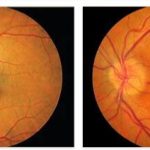Optic neuritis is an inflammation of the optic nerve. It is often an early symptom of multiple sclerosis.
What is optic neuritis?
In medicine, neuritis nervi optici is also known as optic neuritis or inflammation of the optic nerve. If the inflammation occurs within the optic nerve head, it is referred to as papillitis, but if it occurs in the posterior segment of the optic nerve, it is retrobulbar neuritis. Optic neuritis is accompanied by swelling of the nerve fibers located on the optic nerve head and by circulatory disorders. See percomputer for Cretinism Explanation.
This poses a risk of optic nerve damage and vision loss. In the worst case, blindness can result. In most cases, optic neuritis is unilateral. The condition is also considered an early sign of multiple sclerosis. People between the ages of 20 and 45 are particularly affected by optic neuritis. The disease is more common in women than in men.
Causes
Optic neuritis has different causes. It is not uncommon for it to appear in the context of multiple sclerosis, which is an autoimmune disease. The myelin sheaths of the nerves are attacked. Impairment of the myelin sheaths disrupts the transmission of nerve signals. However, other autoimmune diseases such as lupus erythematosus and sarcoidosis can also cause optic neuritis.
Children can also get optic neuritis. They usually have papillitis caused by common infections such as a cold. However, no specific cause for the inflammation can be found in around 70 percent of all sick children. Sometimes the optic nerve inflammation occurs as a result of diseases such as malaria, Lyme disease or syphilis. Occasionally, sinusitis (inflammation of the paranasal sinuses) is the trigger for optic neuritis.
Symptoms, Ailments & Signs
The main symptom of optic neuritis is the deterioration of vision. A significant impairment of vision can occur within days or even hours. The loss of vision is primarily noticeable in the central section of the visual field. The affected person sees as if through a gray veil or frosted glass.
In addition, pain in the eye occurs, which is triggered by eye movements. The pain is often perceived very differently. They can be stabbing, throbbing, dull, or diffuse. In addition, the eyes are extremely sensitive. It is not uncommon for the patient to also suffer from color saturation disorders or color blindness, which is particularly the case with the color red.
The pain can also be intensified by heat, which doctors call the Uthoff phenomenon. For example, if the patient takes a warm bath, this often leads to a deterioration in vision. Flashes of light also occur in around 30 percent of all patients. Pressure and bright light are also painful.
Diagnosis & course of disease
If the symptoms of neuritis nervi optici lead the patient to the doctor, the doctor will first ask a few questions. For example, he would like to know whether there is pain when the eyes move, whether one eye sees worse than the other, since when the vision has deteriorated, whether there have been flu infections or feverish illnesses recently and whether there is a cardiovascular disease.
Also of importance are possible multiple sclerosis cases within the family, whether the patient perceives flashes of light and whether he consumes alcohol or tobacco and takes medication regularly. The survey is followed by determining visual acuity, with the patient reading letters and numbers on a board. The doctor shines a small lamp into your eyes to test pupil response.
The mobility of the eyes is also checked. The patient follows the doctor’s finger or a pen and indicates whether he feels pain or sees double vision. An examination of the fundus of the eye is also carried out. To do this, the doctor shines an ophthalmoscope (eye mirror) into the eye to assess the retina.
Other diagnostic methods include checking color perception and testing optic nerve conduction. If multiple sclerosis is suspected, magnetic resonance imaging (MRI) or a lumbar puncture can be performed. If multiple sclerosis is responsible for the inflammation of the optic nerve, medical treatment can improve vision.
Otherwise, the course of the neuritis nervi optici is different. Sometimes the inflammation lasts for two weeks and then improves spontaneously. In severe cases, the symptoms can also last permanently.
Complications
An inflammation of the optic nerve, called neuritis nervi optici, can have various causes and is often an indicator of the onset of multiple sclerosis (MS). The type of complications that occur depends on the factors causing the nerve inflammation and the location of the focus of inflammation. It can be located directly in the area where the nerve fibers exit the eyeball (papillitis) or in the back of the optic nerve in the form of retrobulbar neuritis.
Typical complications are visual impairment, blurred vision and pain in the eye with eye movements. In addition, the eyes are sensitive to light stimuli and flashes of light are seen in about a third of all cases. If those affected do not have high blood pressure, diabetes or tuberculosis, the nerve inflammation often heals without treatment and the symptoms can disappear completely.
In other cases, root-cause treatment is required to resolve the symptoms and complications. If the inflammation of the optic nerve is triggered by an autoimmune reaction, therapy that suppresses the immune system, such as immunosuppressants, is helpful. In these cases, if left untreated, the symptoms would worsen, which in extreme cases would lead to complete blindness in the affected eye. Heavy smoking and excessive alcohol consumption have an unfavorable effect on the course of the disease.
When should you go to the doctor?
In the case of a decrease in vision, a doctor’s visit is always necessary. If the person concerned notices the first loss of vision in everyday life, he should act immediately. It must be clarified whether this is a natural aging process or a serious illness. To reduce the risk of an accident or fall, a doctor should be consulted. A change in color perception, blurred vision, or an inability to see people or objects in detail must be investigated. If the person affected notices that their eyesight has deteriorated in direct comparison to people in their social environment, they need help. A headache or a feeling of pressure around the eyes is cause for concern.
If the symptoms persist for several days, if they increase in intensity or if they occur repeatedly, a doctor should be consulted. Some sufferers also complain of pain in the eye region. This can go into the head or radiate into the field of vision. Both indications should be presented to a doctor. If the pain occurs when exposed to light, this is a cause for concern and action is required. If there are changes or abnormalities in the field of vision, these must be medically clarified. If you see flashes of light, flickering or the perception of unusual shadowy contours, a doctor’s visit is advisable.
Treatment & Therapy
The therapy of neuritis nervi optici depends on its causes. If the inflammation is triggered by multiple sclerosis, the patient is given immunosuppressants. They suppress the immune system. These are mostly glucocorticoids such as methylprednisolone or cortisone. Your dosage is high at the start of therapy and is lowered over time.
However, the patient must not suffer from high blood pressure, diabetes, stomach ulcers or tuberculosis, as this would lead to a worsening of the diseases. Later, a special treatment for multiple sclerosis takes place.
If bacteria are the trigger of the optic neuralgia, the patient can be given antibiotics. In principle, the patient must take it easy and stay in bed. Since the inflammation of the optic nerve often resolves spontaneously without treatment, special treatment is not always necessary.
Outlook & Forecast
If the diagnosis is made quickly and early, the further course of the disease is favorable in most patients. The existing inflammation is treated by administering medication, so that a complete freedom from symptoms is possible within a few days or weeks. The prerequisite for a good prognosis is a basically intact immune system and a patient who does not have any other diseases.
Nevertheless, the affected person should seek medical support even if they are in good general condition, as otherwise the existing symptoms can quickly increase and further loss of vision can occur. The disease is characterized by the rapid progression of the disease and in many cases indicates the presence of another underlying disease. For this reason, the use of medical care is advisable.
If other diseases are present, the otherwise favorable prognosis often deteriorates. Complications and other health challenges are to be expected, particularly in patients with a chronic underlying disease or persistent blood pressure problems. Chronic complaints can occur and the quality of life is reduced. Many patients must maintain bed rest to experience long-term symptom relief. If the course of the disease is unfavorable, multiple sclerosis is diagnosed later. The loss of vision is often an indication of the present disease.
Prevention
Preventive measures against optic neuritis are not known. However, it makes sense to avoid tobacco and alcohol.
Aftercare
In the case of optic neuritis, in most cases there are only very few and only very limited measures or options for direct aftercare available. For this reason, those affected should consult a doctor very early on to prevent the occurrence of other symptoms and complications. It can also not come to a complete healing, so those affected should contact a doctor.
Optic neuritis is usually treated by taking various medications. Those affected should always ensure that they are taken regularly and that the dosage is correct. All the doctor’s instructions must also be followed, and if you have any questions or are unclear, you should always consult a doctor first.
If the neuritis nervi optici is treated by taking antibiotics, no alcohol should be drunk during the treatment. Patients often depend on the help of their own families in everyday life. This can also prevent the development of depression and other mental disorders. In most cases, this disease does not reduce the patient’s life expectancy, and the further course depends very much on the time of diagnosis.
You can do that yourself
If it can be ruled out that an autoimmune disease is the cause of the disease, there are ways to prevent a new disease.
Since the triggers of the disease are unfortunately often not sufficiently known, it is of course difficult to take the right steps. What is certain, however, is that toxins and irritants can trigger optic neuritis, which is why contact with them must be avoided as much as possible. These include not only aggressive cleaning agents or sprays, but also alcohol, nicotine and bitter drinks mixed with quinine. A healthy diet with few additives can ensure a low-irritant environment and minimize the risk of a new illness. If you are unsure, a nutritionist will be happy to help and develop an individual nutrition plan.
The immune system itself also plays a very important role, and not just in the case of an infection-related illness. In most cases, little stress, enough sleep and a healthy diet ensure an intact immune system. This can largely defend itself against pathogens by recognizing the pathogens and eliminating them at an early stage. Only when the pathogen density is too high do the corresponding symptoms appear.
With every sign of a new disease, no matter how small, an ophthalmologist must be consulted immediately, who can initiate appropriate treatment immediately and thus counteract the possible loss of vision at an early stage.





